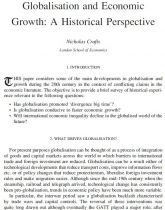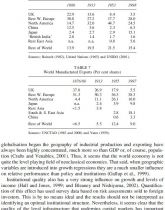Studijní materiál: Globalisation and Economic Growth: A Historical Perspective
Skrýt detaily | Oblíbený- Kvalita:88,8 %
- Typ:Studijní materiál
- Univerzita:Vysoká škola ekonomická v Praze
- Fakulta:Fakulta financí a účetnictví
- Kategorie:Ekonomika
- Podkategorie:Světová ekonomika
- Předmět:Světová ekonomika
- Autor:modrehory
- Ročník:2. ročník
- Rozsah A4:14 strán
- Zobrazeno:1 671 x
- Stažené:0 x
- Velikost:0,2 MB
- Formát a přípona:PDF dokument (.pdf)
- Jazyk:anglický
- ID projektu:3456
- Poslední úprava:26.05.2014
1. INTRODUCTION
THIS paper considers some of the main developments in globalisation and
growth during the 20th century in the context of conflicting claims in the
economic literature. The objective is to provide a brief survey of historical experience
relevant to the following questions:
• Has globalisation promoted ‘divergence big time’?
• Is globalisation conducive to faster economic growth?
• Will international economic inequality decline in the globalised world of the
future?
2. WHAT DRIVES GLOBALISATION?
For present purposes globalisation can be thought of as a process of integration
of goods and capital markets across the world in which barriers to international
trade and foreign investment are reduced. Globalisation can be a result either of
technological developments that reduce transport costs, improve information flows
etc. or of policy changes that reduce protectionism, liberalise foreign investment
rules and make migration easier. Although since the mid-19th century when the
steamship, railroad and telegraph arrived, technological change has consistently
been pro-globalisation, trends in economic policy have been much more variable.
In particular, the interwar period saw a globalisation backlash characterised
by trade wars and capital controls. The reversal of these interventions was
quite long drawn out although eventually the GATT played a major role; after
the demise of the Bretton Woods international monetary system macroeconomic
policy favoured international capital mobility. In this respect, the role of the
macroeconomic policy trilemma deserves to be noted, namely, that it is possible
for a country to have at most two of a fixed exchange rate, independent monetary
policy and free international movement of capital. Among the world’s leading
economies the choice of what to give up varied over time; before 1914 typically
monetary policy was sacrificed, in the 1950s capital mobility was forgone but
since 1971 the fixed exchange rate has been abandoned.
Globalisation is not easy to measure and these issues cannot be addressed here.
Tables 1 and 2 do, however, give a useful sense of the historical experience. The
interwar setback to globalisation and the lengthy period before this was reversed,
show up in the decline of the ratio of foreign assets to world GDP from 17.4 per
cent in 1914 to 4.9 per cent at the end of World War II and the fact that the 1914
ratio was not attained again until 1980. The decline in world trade between 1929
and 1950 from 9.0 to 5.5 per cent was somewhat less dramatic and was made
good by the late 1960s. But the most striking feature of these tables is the extent
to which globalisation in the modern world goes beyond previous peaks.
THIS paper considers some of the main developments in globalisation and
growth during the 20th century in the context of conflicting claims in the
economic literature. The objective is to provide a brief survey of historical experience
relevant to the following questions:
• Has globalisation promoted ‘divergence big time’?
• Is globalisation conducive to faster economic growth?
• Will international economic inequality decline in the globalised world of the
future?
2. WHAT DRIVES GLOBALISATION?
For present purposes globalisation can be thought of as a process of integration
of goods and capital markets across the world in which barriers to international
trade and foreign investment are reduced. Globalisation can be a result either of
technological developments that reduce transport costs, improve information flows
etc. or of policy changes that reduce protectionism, liberalise foreign investment
rules and make migration easier. Although since the mid-19th century when the
steamship, railroad and telegraph arrived, technological change has consistently
been pro-globalisation, trends in economic policy have been much more variable.
In particular, the interwar period saw a globalisation backlash characterised
by trade wars and capital controls. The reversal of these interventions was
quite long drawn out although eventually the GATT played a major role; after
the demise of the Bretton Woods international monetary system macroeconomic
policy favoured international capital mobility. In this respect, the role of the
macroeconomic policy trilemma deserves to be noted, namely, that it is possible
for a country to have at most two of a fixed exchange rate, independent monetary
policy and free international movement of capital. Among the world’s leading
economies the choice of what to give up varied over time; before 1914 typically
monetary policy was sacrificed, in the 1950s capital mobility was forgone but
since 1971 the fixed exchange rate has been abandoned.
Globalisation is not easy to measure and these issues cannot be addressed here.
Tables 1 and 2 do, however, give a useful sense of the historical experience. The
interwar setback to globalisation and the lengthy period before this was reversed,
show up in the decline of the ratio of foreign assets to world GDP from 17.4 per
cent in 1914 to 4.9 per cent at the end of World War II and the fact that the 1914
ratio was not attained again until 1980. The decline in world trade between 1929
and 1950 from 9.0 to 5.5 per cent was somewhat less dramatic and was made
good by the late 1960s. But the most striking feature of these tables is the extent
to which globalisation in the modern world goes beyond previous peaks.


